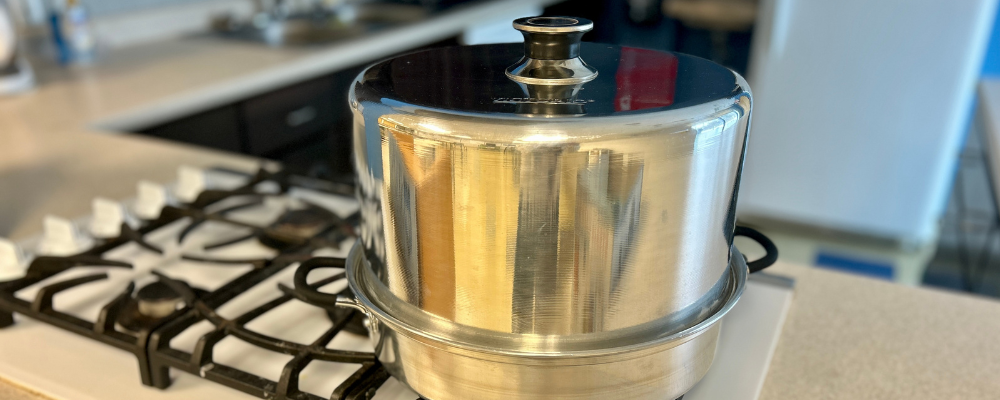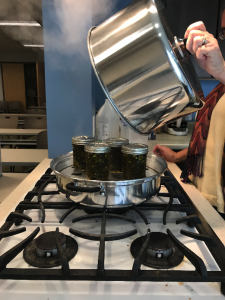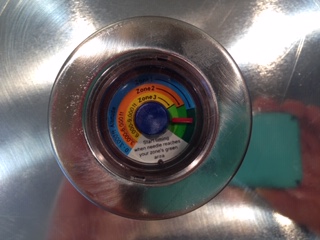
Using An Atmospheric Steam Canner Safely
— By Kate McCarty, Food Systems Professional, University of Maine Cooperative Extension

Home canners will be interested to learn that there’s another type of canner recommended for preserving high-acid foods at home. An atmospheric steam canner, an appliance designed to preserve foods using steam, has been sufficiently tested by the University of Wisconsin, National Center for Home Food Preservation, and USDA for us to recommend it as an approved way to can high-acid foods. The atmospheric steam canners tested and recommended are the Back to Basics and Victorio brands (for more information on why only certain brands can be used, visit this University of Wisconsin blog post on steam canning).
In other words, home canners may use an atmospheric steam canner in place of a boiling water bath canner for high-acid foods, using a tested recipe. As with all preserving methods, you must follow the proper procedures and guidance for using an atmospheric steam canner.
My coworker Extension Educator Kathy Savoie and I tried out an atmospheric steam canner by pickling the last of the season’s jalapenos from the Portland Farmers’ Market last fall. An atmospheric steam canner has a shallow base with a rack and a large dome lid. The lid has a temperature indicator that lets you know when to begin your processing time. The aluminum pot holds 8 pints and 7 quarts, much like a boiling water bath canner does.
To operate the atmospheric steam canner, fill the bottom portion of the pot with about 2-1/2 quarts of water, which will make the water level even with the rack. Preheat the water to a simmer while you prepare your recipe. Use standard canning jars with a two-part dome lid and screw band and preheat your jars before filling, just as you would when using a boiling water bath canner.
Prepare your recipe and fill jars as directed by a tested recipe; once jars are filled, place jars on the rack inside the atmospheric steam canner. Apply the lid with the vent holes facing away from you, and bring the water to a boil. As soon as steam appears from the vent holes, vent the canner for one minute. After one minute of venting, begin the processing time for your product and jar size.

The indicator has three zones that correspond to different altitude ranges. Higher elevations affect the temperature at which water boils, so you need to make adjustments if you are canning above 1,000 feet. Once you’ve found your zone on the temperature indicator, watch the indicator needle as it rises toward the green area. When the needle holds steadily in the green, you can start the processing time. You must keep the needle in the green zone during the whole processing time. You can adjust your stove’s heat as long as the ASC indicator stays in the green zone.
Two important notes to consider when using an atmospheric steam canner:
- Atmospheric steam canners can only be used for items that have 45 minutes or less of processing time due to the risk of the canner boiling dry. If the canner boils dry during processing, the jars are not safe for long term storage and need to be reprocessed properly.
- After your jars have been processed and removed from the canner, it’s important to cool them in still air (meaning, not drafty). Cooling jars in a drafty room could cause the jars to seal too quickly. So be sure to close any open windows and turn off any fans before you remove your jars from the canner.
Once the processing time has passed, carefully remove the canner from the heat. If desired, let the canner stand for 5 minutes, and then remove the lid so that the steam escapes away from you. Let the jars cool, undisturbed, on the counter for 12-24 hours until the seals form. Once sealed, label, date, and store jars without screw bands as you would any other home canned goods.

The benefits of the steam canner are that it uses less water (about 2 quarts instead of the 16 quarts used in a boiling water bath) and therefore less energy to heat the water to the proper temperature. A drawback is that it’s a specially-designed piece of equipment and must be purchased, rather than adapted from another pot you may already have, like a boiling water bath can be. But if you’re interested, we hope you check out an atmospheric steam canner and enjoy the process.
Resources
- An update on safe use of steam canners (University of Wisconsin)
- Burning Issue: Using Atmospheric Steam Canners (NCHFP)
- Pickled Jalapeno Rings Recipe (NCHFP)
- Safe Preserving: Using a Steam Canner (University of Wisconsin)
- Steam Canning (South Dakota State University)
- UMaine Food Preservation Workshops
